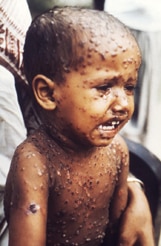How infectious diseases are spread and simple and practical advice for preventing the spread of infection in the home and community
Smallpox - including symptoms, treatment and prevention
Smallpox, which was once a severe disease common around the world, was certified as globally eradicated by the World Health Assembly in 1980 after a successful worldwide immunisation campaign. The last naturally occurring case was detected in Somalia in 1977. Stocks of smallpox virus exist in two laboratories in the United States of America and Russia.
There were two forms of smallpox, variola major (which was more common and more severe) and variola minor.
Smallpox is a notifiable condition1.
How Smallpox is spread
Smallpox is caused by the variola virus and is spread from person to person.
Smallpox is spread when an infected person talks, coughs or sneezes small droplets containing infectious agents into the air. The droplets in the air may be breathed in by those nearby or may contaminate objects.
Smallpox can also be spread by direct contact with blister fluid or contaminated objects.
Smallpox is a potential bioterrorism agent.
Signs and symptoms of smallpox
 Signs and symptoms of smallpox may include:
Signs and symptoms of smallpox may include:
- sudden onset of high fever which may be recurrent
- malaise (general feeling of unwellness)
- widespread skin rash – flat spots which change into raised bumps then firm fluid filled blisters which then scab (see image)
- severe headache
- backache
- abdominal pain
- vomiting
- diarrhoea.
In 30 to 50% of unvaccinated people with variola major the disease progressed with bleeding, low blood pressure, multi-organ failure and death.
Variola minor had a death rate of less than 1%.
Diagnosis of smallpox
Diagnosis is by laboratory testing of blister fluid or skin scrapings, or blood taken during the fever stage.
Incubation period
(time between becoming infected and developing symptoms)
From 7 to 19 days, usually 10 to 14 days.
Infectious period
(time during which an infected person can infect others)
From the start of the fever until all scabs have fallen off. People are most contagious during the early skin rash.
Treatment for smallpox
There is no specific treatment for smallpox. Persons with suspected or confirmed smallpox require supportive treatment in hospital.
Prevention of smallpox
- Exclude people with smallpox from childcare, preschool, school and work from the start of the illness until all scabs have disappeared and they have been advised by the Chief Quarantine Officer in SA Health that they may return.
- A vaccine is available. Vaccination against smallpox is not routinely recommended in Australia and is not on the National Immunisation Program schedule. Vaccination is recommended for laboratory staff who routinely work with vaccinia poxviruses (unless contraindicated).
- There is a small risk that smallpox could be released intentionally as a bioweapon and health departments around the world are planning for this possibility, including South Australia.
- Promptly isolate suspected and confirmed cases of smallpox until no longer infectious.
Useful Links
- When you have a notifiable condition
- Immunisation
- Occupations at risk of vaccine preventable diseases
1 - In South Australia the law requires doctors and laboratories to report some infections or diseases to SA Health. These infections or diseases are commonly referred to as 'notifiable conditions'.
Image - Courtesy of Dr. Michael Schwartz, Public Health Image Library (PHIL), Department of Health and Human Services, Centers for Disease Control and Prevention (CDC-USA)